Advanced Sonata Goes High-tech with Hybrids
Filed under: Equinox, Autos
By John Gilbert
The 2011 Hyundai Sonata was a breakthrough vehicle for the South Korean manufacturer, proving it could out-flank even the Japanese for such technical assets as dramatic contoured styling, a world-class engine with variable valve-timing and other-worldly direct injection, and a new home-built transmission.
Cutting-edge technology, to be sure, but cutting-edge mainstream stuff. Hyundai improved on that model with the 2015 Sonata, but even those advancements couldn’t prepare us for the high-tech leap to the 2016 Sonata Hybrid and Plug-in Hybrid models.
Discussing technical assets can make consumers, and some journalists, take on a glazed-over gaze, but all the technology would be meaningless if the Sonata — or any hybrid — didn’t approach normal-driving capabilities. In that regard, the 2016 Sonata Hybrid sets new standards.
You might even think you’ve gotten in the wrong car when you select “Sport” from the three drive modes, then manually command the Shiftronic transmission to rally the combined forces of the gas-engine and electric-motor and transmission for surprising potency.
“Our development goal was to combine the features of economy and fun-to-drive,” said Yong-Seok Kim, project manager for the Sonata Hybrid. “you can set the manual shift mode for Eco, Norm, or Sport. Our research shows that 45 percent drive in Economy, 35 percent in Normal, and 20 percent drive aggressively.
“With our selective control, you can set it for whichever style you want, then adapt, or let the car adapt to you. We’ve reduced the gap between driving and aggressive driving. Whichever way you drive, as you come up to a stop light and release the gas pedal to coast, you can reduce your fuel consumption by 3 percent.”
Without question, first drives of the Sonata Hybrid on the Los Angeles freeways and through the hills around Los Angeles, proved that the car’s performance is easily as good as the hottest-performing Sonatas.
The hybrid models are virtually a separate class from the normal Sonatas. You can choose a base Sonata Hybrid for $26,000, and add features and capabilities to rise to the Limited, or go upward again to reach the Limited Ultimate.
There are more differences between the Hybrid and the Plug-In Hybrid than merely using Clean and informative dash layout shows current fuel economy over 54 mpg in the Sonata Hybrid.plug-in power to fully recharge, and the Plug-in Hybrid starts at $30,100 as a Limited model, moving up to Limited Ultimate for an extra $4,500. Those prices are only moderately more expensive than the non-hybrid Sonata, and they can fetch you a $4,919 tax credit as well.
While the normal Sonata does well with engines ranging from the 2.4 to the 1.6, including a 2.0-liter turbo, the hybrids make use of the same engine, a newly refined 2.0-liter without the turbocharger.
All hybrids depart from the normal Sonata’s styling, with a more aggressive front grille opening, and revisions to the headlight and taillight housings to aid fuel-economy. In the process, the Sonata Hybrid winds up with a segment-best 0.24 coefficient of drag, lowered from the normal Sonata’s 0.27. Fuel economy can venture beyond the EPA estimated 40-44 miles per gallon highway, by altering heavy-footed driving habits.
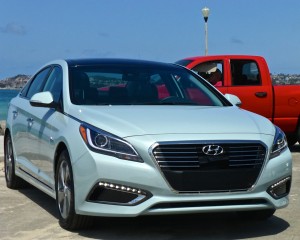
Sonata Hybrids come in Base or Limited, and the plug-in version offers increased power and capability.
By cheating to overuse electric-only power when fully charged, we started out registering 99.9 miles per gallon — because the gadget wouldn’t measure three digits. Continuing beyond about 24 pure-electric miles, we still averaged 68.8 mpg for the first leg. My partner, whose right foot always seems closer to the floor, reached as high as 59.6 mpg at a sustained 70 miles per hour.
The current Sonata had a hybrid model, but it wasn’t about to challenge the industry leading hybrid sedans from Toyota or Honda. The new car challenges everything on the market. To start with, Hyundai will aim sales at the West Coast, where there are an abundance of quick-charge stations. But buyers farther inland can order the Hybrid or Plug-in Hybrid and find their own way to capitalize on all the features.
The secret of advancing hybrid technology is that car companies aren’t in the battery-making business, so coordinating with battery companies is vital. Hyundai has a fellow-South Korean ally in LG Industries, and a newly created LG Lithium-polymer battery pack feeds Sonata’s permanent magnetic synchronous motor and clutch arrangement, with is located where the 6-speed automatic transmission’s torque converter normally would be. That unique coupling is the ideal way to blend the electric power with that new 2.0-liter gas 4-cylinder engine.
Taking away the turbo reduces the power of the normally-aspirated 2.0, but it gets more than sufficient power with the added power surge from the electric motor. In fact, the power assist comes in two doses, depending on whether you have the normal or the plug-in hybrid.
The 2.0 gas engine by itself has 154 horsepower peaking at 6,000 RPMs, and 140 foot-pounds of torque at a high 5,000-rev peak. The LG battery unit with its vertical plates in a more compact alignment, adds 51 horsepower from a 1,770-2,000 RPM peak in the Hybrid, or 67 added horsepower from 2,330-3,330 RPMs in the Plug-in Hybrid. Both benefit from the boost of 151 foot-pounds of torque from the electric motors, which operate at that peak all the way from 0-1,770 RPMs.
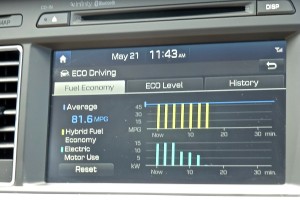
Alterations to the 2016 Sonata Hybrid are more attractive with the chance to beat 50 miles per gallon.
Doing the math, the Sonata Hybrid has 193 horsepower, and the Plug-in Hybrid has 202 horsepower. A larger battery pack is needed for the added power, and that boosts the weight of the Hybrids (3,497-3,560 pounds) to the Plug-in’s 3,787-3,810 pounds. But starting out in the morning with a full charge means you can drive the full 24 miles on pure electric, which exceeds the prime contenders, the Fusion Energi and the Accord plug-in hybrid.
Getting to that full charge offers an interesting choice, too. If you plug into a normal household outlet of 110/120 volts (Level 1), you’ll need 9 hours to reach full charge. If you have the 220/240 Level 2 outlet, you can reach full charge in only three hours. Using the normal internal charging system that takes power from the gas engine and regenerative braking means an owner could drive the Sonata Hybrid “normally” and not realize it’s a hybrid from performance, unless the over-40 mpg made the driver curious.
Hyundai’s John Shun, who oversees Sonata Hybrid production, said, “You can maximize miles per gallon over fun-to-drive, or vice versa. For example, in Sport, you get immediate throttle response, in Normal you get normal response, and in Eco, there’s more hesitation when you use regular throttle pressure.”
For the curious, you can coax the Sonata Hybrid up to 75 miles per hour on pure electric, although that might drain the battery’s power quicker. Shun said all the latest safety tricks are on the Sonata Hybrids, including blind spot detection, lane departure warning, a rear parking sensor, and forward collision warning, and so anxious are Hyundai engineers to make the Sonata safe, a “virtual” engine sound system will be coming next, to alert pedestrians who might not hear the electric-powered hybrid approaching while doing their text-walking maneuvers.
Other neat features include a 5-inch touchscreen and an 8-speaker audio, an upgraded 8-inch screen and a 9-speaker, 400-watt audio, or an electroluminescent instrument light show that can replace the tachometer with a power-consumption gauge, and includes a 4.2-inch trip computer. Buyers can choose an energy gauge that indicates battery charge, range, and the energy flow the way you are currently driving, and with the Blue-link smart-phone app, you can seek out high-speed charging stations.
In the rear, the Sonata boasts of being the only midsize hybrid with a flat cargo floor. Combined with the split fold-down rear seat, cargo volume reaches 13.3 cubic feet, decreased to 9.9 with the larger battery in the Plug-in. Those things might be more important in marketing than such items as the motor-driven, RPM-sensing, rack-and-pinion power steering.
But with the 2016 Sonata Hybrids, buyers have to accept both — creature features and high-technology advances.
Alfa Romeo Doesn’t Spare Theatrics for New Giulia
Filed under: Equinox, Features, Autos
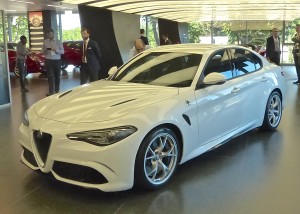
Alfa Romeo unveiled the new Giulia midsize sedan as the focal point of its return to competitiveness.
By John Gilbert
MILAN, Italy — When Italians decide to do something, they tend to do it wearing their emotions on their sleeves. Or at least their fenders. That unrestrained optimism accompanied the world introduction of the new Alfa Romeo Giulia, a sport-luxury sedan that is a perfect example of living up to the hyperbole accompanying that legendary Italian passion.
There is no argument about how important the new Giulia sedan is to “resurrect” Alfa Romeo, just as there is no way to overstate the importance a healthy Alfa Romeo can have for Fiat, and therefore Fiat-Chrysler Automotives, on the world automotive stage. As a midsize sedan, the Giulia is not shooting at Accord, Camry, Fusion, Malibu type sedans. It is aimed directly at the top German performance sedans, such as the BMW M3, the Mercedes AMGs and the Audi S4.
In order to run with, and ahead, of such luminary competitors, governing FCA built an entirely new platform and an entirely new 3-liter V6 with Ferrari engineering. While similar to a Ferrari designed engine used by Maserati in the Ghibli sedan, some media types assume that is the Giulia engine — a point Alfa officials refuted almost to the point of confrontation. We will believe that the Giulia V6 is all new.
Alfa built the mid-size sedan in almost total secrecy, engaging what it calls a “skunk-works” of devoted and single-minded engineers to design and build the car. That term dates back to World War II, when Alfa engineers wanted to hide their latest prize from the Fascist Italian government, and joined the secret Lockheed project to develop the F80 Shooting Star jet fighter that helped hasten the end of the war.
For the Giulia introduction, Alfa summoned several hundred automotive journalists from all over the world to come to Milano where the car shared the spotlight with the opening of the Alfa Romeo museum, with its display of hundreds of vehicles that trace the 105-year history of Alfa car-building.
In the museum’s auditorium, Alfa Romeo president Harald Hester started the show, followed by chief engineer Philippe Krief, and design chief Lorenzo Ramaciotti. When Ramaciotti talked about the passion that is an Italian hallmark, he mentioned how it is similar to Italian classical music, such as that performed by brilliant tenor Andrea Bocelli. At that moment, Bocelli was escorted onstage. He read a love poem he had written, and then he sang “Nessun Dorma,” and when he hit the operatic crescendo, a stunning red Giulia sedan was driven out on the stage behind him.
Theatric overkill? More like colorful Italian tradition.
Sergio Marchione, chairman of Fiat Chrysler Auto, was next at the podium. “Over two years, we developed a quintessential example of all that made Alfa Romeo a car coveted by passionate drivers the world over,” said Marchione. With 510 horsepower and 0-100 [kilometers] acceleration in 3.9 seconds, we have created a car that has no need to be compared to others.
“This is one of the most impressive cars I’ve ever been associated with,” Marchione added, noting that the “skunks” at the skunk-works were able to think outside the box, starting with a clean sheet of paper, and “unimprisoned by barriers we sometimes build for ourselves.”
It’s easy to see why Marchione is the head man at Fiat Chrysler Auto, which includes all things Fiat, Alfa, Ferrari, Maserati, Lancia, Chrysler, Dodge, Ram and Jeep. Fiat returned to the U.S. only after the parent company took over the faltering Chrysler LLC, and is just now reintroducing Alfa Romeo to the U.S. Those old enough to remember might best recall Alfa for the sleek little roadster Dustin Hoffman drove to try to interrupt Katherine Ross’s wedding in the timeless movie, “The Graduate.”

Familiar triangular Alfa center point on the grille links thoroughly modern Giulia with historic past.
While Alfa has slipped in popularity, almost to extinction, its heritage has remained strong, and new models like the 4C sports car and the Giulia are just the beginning of the planned resurrection.
“Alfa Romeo has a legendary place in automotives,” Marchione added. “It has so many admirers throughout the world, but it has not been reflected in commercial success. Other than Ferrari, and maybe Jeep, I don’t know of any other car capable of expanding so much of its core tradition.”
We couldn’t drive the cars, yet, so we had to be satisfied with their stunning appearance, and the deft descriptions by Alfa executives. Hester opened the program describing the uniqueness of the brand and said, “Making and creating are not the same thing. We wanted to create something different, to put the driver back at center stage. An Alfa Romeo is never just a car, just a machine. It is beyond the scope of being just a machine.”
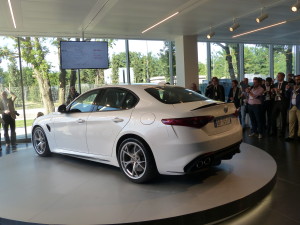
All the sleek lines reach a harmonious conclusion at the rear of the Giulia, which takes aim at the BMW M3.
Chief engineer Krief explained the rear-wheel or all-wheel platform, housing the all-aluminum 6-cylinder bi-turbo engine, featuring Ferrari technology and engineering skill. “Turbo lag is nonexistent, and it has excellent torque at all RPMs,” Krief said. “It also has cylinder deactivation, and Alfa invented that technology in the early-‘80s. We then worked to get the engine to sing, as it should. The Giulia has 50-50 weight distribution, and our level of driving enjoyment depends on the suspension, which has ‘Alfa Link’ at the rear for maximum movement control, and double wishbone in front with a new steering system that is the most direct on the market. It has carbon ceramic brakes, and the best torsional rigidity in its class.
“Electronics are used to increase performance, not cover up shortcomings, and it has real torque-vectoring, with a double clutch system to separate the torque going to each wheel. Rear-wheel drive can be a problem on slippery roads, which is why we also offer all-wheel drive. The response is quick and it has the lowest coefficient of drag in the segment, with a front aero splitter, so it is safe to drive, even at very high speed.”
The interior is filled with classic features, real wood and real leather surrounding everything, including a console that has two round knobs. The left knob is smaller, thankfully, and it directs the driver to N, A, D, and Race. The N is for normal operation, the A is for Advanced, the D for Dynamic — which is more advanced — and the Race is for a full-out race-smooth performance setting. That control governs the direct-sequential gearbox as well as the suspension firmness and the amount of effort necessary to send the Giulia down the road.
Design chief Ramaciotti said the organically shaped car “challenges time, passion and space with its tension — part of the culture at Alfa Romeo. The short overhangs, long wheelbase, compact body, and simplicity” is the feature of the exterior, with its Alfa-emblem nose and elegant silhouette. Inside, he said, “all you see is leather, wood and carbon fiber. The whole package is a coveted object of desire, not an ornament.”
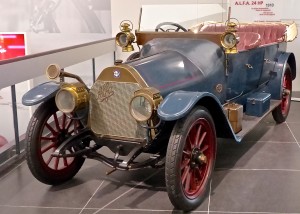
Alfa takes great pride in building passionate cars, starting with the first one, this 1910 museum piece.
Marchione said FCA plans a rapid expansion for Alfa, which reportedly includes a crossover SUV/van, a larger sedan, and enough other models to sell 400,000 vehicles worldwide by 2018. The museum, filled with classic vehicles dating from the 1910 model and on up to the current era, including 1937 and ’38 Giulia and Giulietta models, and a Gran Primo race car that had two Ferrari V12 engines — one in front and one behind the cockpit.
“It will be easy to rediscover Alfa Romeo’s identity,” said Marchione, “because Alfa has lived through, and often written, so much history.”


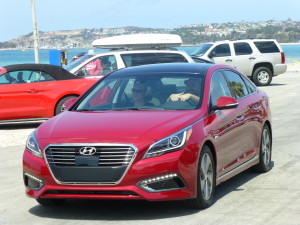

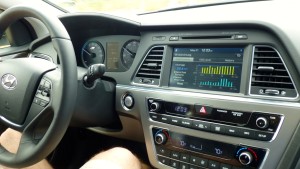


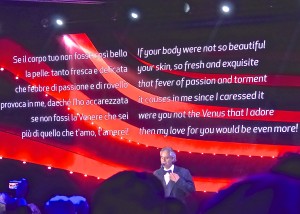
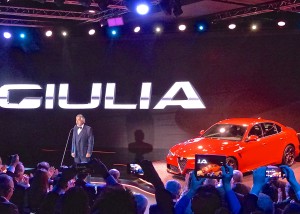
 John Gilbert is a lifetime Minnesotan and career journalist, specializing in cars and sports during and since spending 30 years at the Minneapolis Tribune, now the Star Tribune. More recently, he has continued translating the high-tech world of autos and sharing his passionate insights as a freelance writer/photographer/broadcaster. A member of the prestigious North American Car and Truck of the Year jury since 1993. John can be heard Monday-Friday from 9-11am on 610 KDAL(www.kdal610.com) on the "John Gilbert Show," and writes a column in the Duluth Reader.
John Gilbert is a lifetime Minnesotan and career journalist, specializing in cars and sports during and since spending 30 years at the Minneapolis Tribune, now the Star Tribune. More recently, he has continued translating the high-tech world of autos and sharing his passionate insights as a freelance writer/photographer/broadcaster. A member of the prestigious North American Car and Truck of the Year jury since 1993. John can be heard Monday-Friday from 9-11am on 610 KDAL(www.kdal610.com) on the "John Gilbert Show," and writes a column in the Duluth Reader.